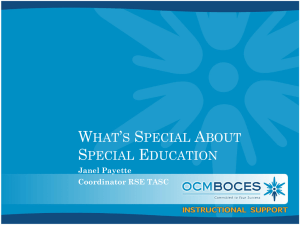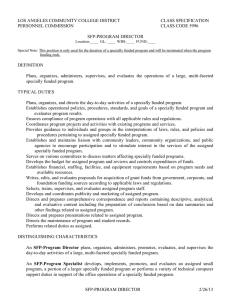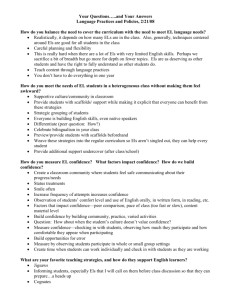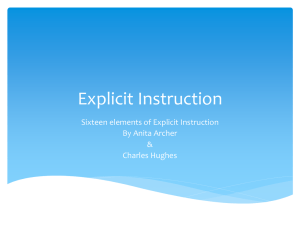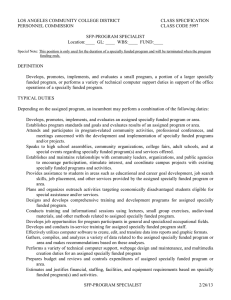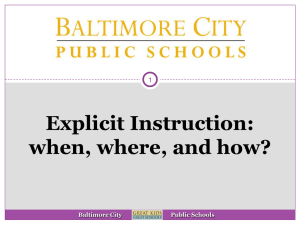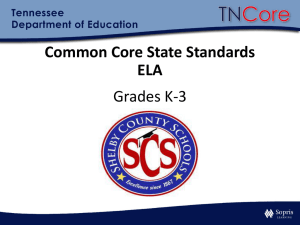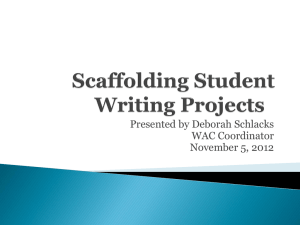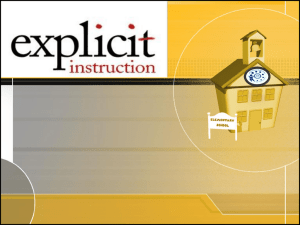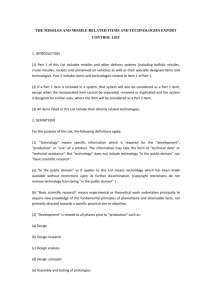explicit instruction
advertisement
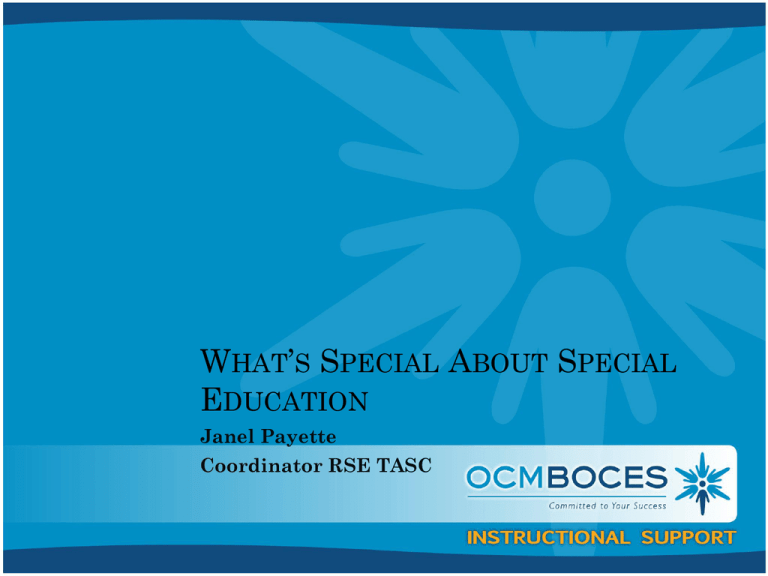
WHAT’S SPECIAL ABOUT SPECIAL EDUCATION Janel Payette Coordinator RSE TASC The Common Core is the DESTINATION, not the journey. Stated another way: It’s the WHAT, not the HOW. SPECIALLY DESIGNED INSTRUCTION “THE HOW” Adapting, as appropriate to the needs of an eligible student, the content, methodology, or delivery of instruction to address the unique needs that result from the student’s disability; and to ensure access of the student to the general curriculum, so that he or she can meet the education standards that apply to all students. 200.1(vv) SPECIALLY DESIGNED INSTRUCTION OPERATIONAL DEFINITIONS Adapting: making changes matched to student need or condition Content: knowledge and skills that comprise curriculum to be mastered Methodology: actions by the teacher intended to produce or facilitate learning which includes the art and science of instruction (ex: teaching strategies including pacing, promoting active student engagement, positive classroom management – best practice and explicitly taught although not necessarily specially designed instruction) Delivery of instruction: teaching that results in access to, participation in, and progress in the curriculum for students with disabilities (ex: explicit instruction of learning strategies, task analysis, preteaching essential vocabulary, re-teaching specific skills or concepts, etc.) SPECIALLY DESIGNED INSTRUCTION CRITICAL ELEMENTS Individualized Based upon assessed needs of student Documented in the Individualized Education Program (IEP) Combination of specific instructional supports & supplemental supports SPECIALLY DESIGNED INSTRUCTION CAN ENCOMPASS DIFFERENT COMBINATIONS OF A VARIETY OF PROVISIONS FOR STUDENTS WITH DISABILITIES IN ORDER TO MEET THEIR INDIVIDUAL NEEDS: Accommodations-environmental changes and the way we deliver instruction Modifications-changes made to the curricular content or skills Specialized equipment and/or adaptive technologyitem, piece of equipment, or product system that is used to increase, maintain, or improve the functional capabilities of a student with a disability. Strategy Instruction –Explicitly teaching students about strategies and how and when to use strategies, helping students identify personally effective strategies and supporting them as they make strategic behaviors part of their learning schema CONTINUUM OF SERVICES Direct Consultant Teacher Indirect Consultant Teacher *Integrated Coteaching General Education Setting Special Class Resource Services Related Services H/O SDI Explicit Direct Instruction and Scaffolding SDI is adapting, as appropriate to the needs of an eligible student, the content, methodology, or delivery of instruction to address the unique needs that result from the student’s disability; and to ensure access of the student to the general curriculum Differentiated Instruction Universal Design for Learning DI is an educational philosophy that values that all students have unique needs. Here, you will start to see some differences in instruction based on students’ interests, readiness, or learning styles. These differences are based on data collected by the teacher. In the provision of effective instruction, differentiation occurs for the benefit of maximizing the learning of all students. UDL is a set of principles for curriculum development and delivery of lessons that support the learning of all students with a variety of learning styles. It gives all individuals equal opportunities to learn by minimizing barriers to learning in order to provide access to all student learning styles and needs in the classroom. The “root of good, effective instruction for all students. 9 Differentiated Instruction Universal Design for Learning all students regardless of select goals, methods, differences in ability assessment and materials in access different a way that will minimize avenues barriers and maximize 1. to acquiring content; flexibility 2. to processing, constructing, 3. or making sense of ideas; 1. Recognition learning, provide multiple, flexible methods of presentation 2. strategic learning, provide multiple, flexible methods of expression and apprenticeship. 4. to developing teaching materials 3. affective learning, provide In the course of instruction need to differentiate instruction multiple, flexible options for engagement Scaffolding provision of sufficient support to promote learning of new concepts and skills for all students The type and amount of support needed is dependent on the needs of the students during the time of instruction (e.g. the teacher may identify hints or cues to help the student reach an even higher level of thinking. ) Overlaps with teaching strategies Specially Designed Instruction • intentionally planned and implemented with fidelity based on identified needs of individual students with disabilities that are absolutely necessary for access, participation and progress in the general education curriculum. H/O UDL, DIFFERENTIATED INSTRUCTION, SCAFFOLDING, SPECIALLY DESIGNED INSTRUCTION Sam has a voice to text program that he learns to edit after dictation Several students have parts of their pre-writing graphic organizer completed for them as an extended model Students use one of three topics of varying difficulty as a basis for their writing Every student may use the word processor and is responsible for editing. WE PROVIDE SPECIALLY DESIGNED INSTRUCTION THROUGH EXPLICIT INSTRUCTION Explicit Instruction is: Structured, systematic Effective researched-based methodology for teaching academic skills and content. In particular for students with disabilities and novice learners Includes instructional design and delivery procedures (I do, we do, you do) Characterized by a series of scaffolds, explanations, demonstrations, and supported practice with embedded feedback. ANATOMY OF AN EXPLICIT LESSON Introduction Active Teaching – part 1 Modeling (I do it) Show and Tell Check for understanding Active Teaching – part 2 Objectives posted and shared Activating of prior knowledge Check for Understanding Guided Practice (we do it) Prompts – physical, verbal, visual Levels of scaffolding (tell, ask, remind them what to do) Active Teaching – part 3 a. Independent Practice (you do it) Lesson Closure RSE TASC WALKTHROUGH TOOL Supportive Accessible Classroom Environment Management Positive Classroom Climate Physical Organization Explicit Instruction Explicit Instruction Teaching Functions Explicit Instruction Elements Specially Designed Instruction Specially Designed Instruction: Direct Instruction of Targeted Skills, Accommodations, Re-Teaching H/O Specially Designed Instruction Explicit Instruction and Scaffolding UDL Differentiating Instruction RESOURCES AND REFERENCES Archer, Anita & Hughs, Charles (2011). Explicit Instruction, New York, NY: Guilford Press. Crocket, L., Jukes, I., Churches, A. (2011). Literacy is Not Enough: 21st Century Fluencies for the Digital Age. Thousand Oaks, CA: Corwin Press. Hollingsworth, John & Ybarra, Silvia (2009). Explicit Direct Instruction, Thousand Oaks, CA: Corwin Corwin Press. Mastropieri, M.A., & Scruggs, T.E. (2005). Effective Instruction for Special Education (3rd Ed.). Austin, TX: Pro Ed. Willingham, D. (2009). Why Don’t Students Like School? San Francisco, CA: Jossey-Bass. Willis, J. (2006). Research-Based Strategies to Ignite Student Learning. Alexandria, VA: Association for Supervision and Curriculum Development. THANK YOU! Janel Payette jpayette@ocmboces.org
